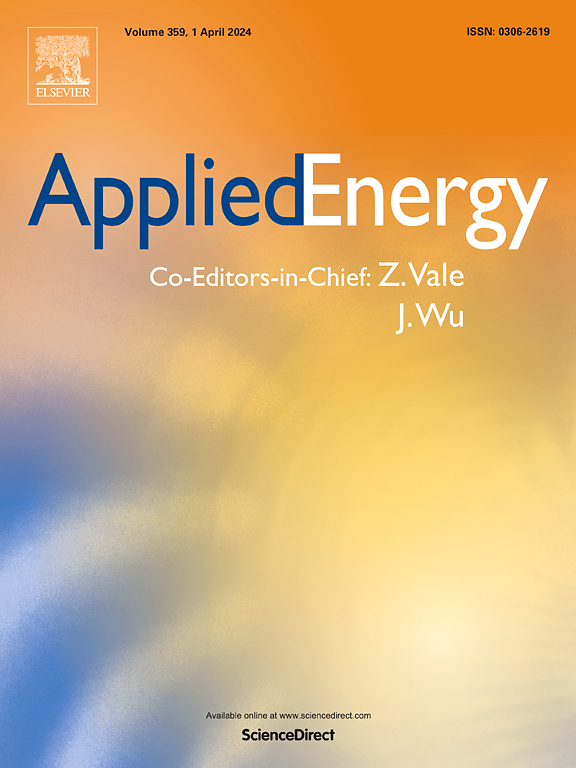岛屿微电网优化混合氢电池储能规划:TSA-THC方法解决多时间尺度失衡
IF 11
1区 工程技术
Q1 ENERGY & FUELS
引用次数: 0
摘要
可再生能源的高波动性对离网岛微电网(OGIM)跨时间尺度的电力平衡提出了重大挑战。混合氢电池储能(HHBS)提供了一种有效的解决方案,可以缓解不同时间范围内的电力不平衡。然而,规划HHBS通常需要全年的操作考虑,由于大量的变量,导致大量的计算复杂性。为了解决这一问题,提出了一种将时间序列聚合(TSA)和时间范围压缩(THC)相结合的规划方法,在不影响规划精度的前提下优化计算效率。该方法保留了储氢系统的长运行周期特性,同时最小化了电池相关变量,从而保证了计算可行性和准确性之间的平衡。THC方法减少了电池运行时间尺度,提高了计算效率,而TSA方法指导了操作顺序,确保了电池的精确规划。开发了一个HHBS规划模型,以在不同的时间尺度上共同优化HHBS容量,最大限度地降低综合成本,包括投资、运营、维护、缩减、减载和燃料成本。采用区间方法对海岛源负荷不确定性进行建模,并通过区间优化方法将不确定规划模型转化为确定性规划模型。南海OGIM实例验证了该方法的有效性,与全年时间尺度方法相比,计算时间缩短了50.33%,将HHBS容量误差限制在0.87%以内。本文章由计算机程序翻译,如有差异,请以英文原文为准。
Optimized hybrid hydrogen-battery storage planning for Island microgrids: A TSA-THC approach for addressing multi-time-scale imbalances
The high volatility of renewable energy presents significant challenges for electricity balancing in off-grid island microgrids (OGIM) across multiple time scales. Hybrid hydrogen-battery storage (HHBS) offers an effective solution to mitigate electricity imbalances over various time horizons. However, planning HHBS typically requires year-round operational considerations, leading to substantial computational complexity due to the large number of variables. To address this challenge, a novel planning method that integrates time series aggregation (TSA) and time horizon compression (THC) is proposed to optimize computational efficiency without compromising planning accuracy. This method preserves the long operational cycle characteristics of hydrogen storage (HS) while minimizing battery-related variables, thus ensuring a balance between computational feasibility and accuracy. The THC method reduces the battery operation time scale to increase computational efficiency, whereas the TSA guides the operation sequence, ensuring precise battery planning. An HHBS planning model is developed to co-optimize HHBS capacity across different time scales, minimizing combined costs, including investment, operation, maintenance, curtailment, load shedding, and fuel costs. Source-load uncertainty on islands is modelled using intervals, and the uncertain planning model is converted into a deterministic model via the interval optimization (IO) method. Case studies on the OGIM in the South China Sea validate the effectiveness of the proposed method, reducing the computational time by 50.33 % and limiting the HHBS capacity error to no more than 0.87 % compared with the year-round time scale method.
求助全文
通过发布文献求助,成功后即可免费获取论文全文。
去求助
来源期刊

Applied Energy
工程技术-工程:化工
CiteScore
21.20
自引率
10.70%
发文量
1830
审稿时长
41 days
期刊介绍:
Applied Energy serves as a platform for sharing innovations, research, development, and demonstrations in energy conversion, conservation, and sustainable energy systems. The journal covers topics such as optimal energy resource use, environmental pollutant mitigation, and energy process analysis. It welcomes original papers, review articles, technical notes, and letters to the editor. Authors are encouraged to submit manuscripts that bridge the gap between research, development, and implementation. The journal addresses a wide spectrum of topics, including fossil and renewable energy technologies, energy economics, and environmental impacts. Applied Energy also explores modeling and forecasting, conservation strategies, and the social and economic implications of energy policies, including climate change mitigation. It is complemented by the open-access journal Advances in Applied Energy.
 求助内容:
求助内容: 应助结果提醒方式:
应助结果提醒方式:


